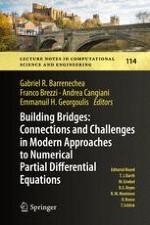2016 | Buch
Building Bridges: Connections and Challenges in Modern Approaches to Numerical Partial Differential Equations
herausgegeben von: Gabriel R. Barrenechea, Franco Brezzi, Andrea Cangiani, Emmanuil H. Georgoulis
Verlag: Springer International Publishing
Buchreihe : Lecture Notes in Computational Science and Engineering
